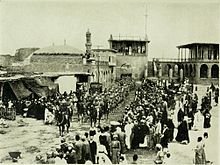
Back الإعلان الإنجليزي الفرنسي Arabic Declaración Anglo-Francesa Spanish Deklarasi Inggris-Prancis ID Declaração Anglo-Francesa Portuguese

The Anglo-French Declaration was published by Great Britain and France, shortly after the Armistice of Mudros saw the capitulation of the Ottoman Empire. Some sources mention as publication date 7 November 1918,[1][2] others 9 November 1918.[3]
The declaration attempted to explain the reason why the two powers had decided to take part in the battle for Ottoman territories. France and Great Britain contended that their intentions were "the complete and final liberation of the people" who had been oppressed by the Ottoman Empire, and the establishment of democratic governments in Ottoman Syria, Ottoman Palestine, Ottoman Iraq (Mesopotamia), and other territories still to be assisted in obtaining their "liberation".
The declaration made it explicit that the form of the new governments was to be determined by local populations rather than imposed by the signatory powers. The declaration was meant to allay Arab suspicions of possible European colonialist or imperialist ambitions.[4][5][6]
- ^ Cite error: The named reference
cmd_5974was invoked but never defined (see the help page). - ^ Cite error: The named reference
a_364add1was invoked but never defined (see the help page). - ^ The King-Crane Commission Report, August 28, 1919, II-The Report Upon Mesopotamia.
- ^ Zara S. Steiner, The lights that failed: European international history, 1919-1933, Part 720, Oxford history of modern Europe, Oxford University Press, 2005 p. 104, ISBN 0198221142
- ^ Bruce Westrate, The Arab Bureau: British Policy in the Middle East 1916 - 1920, Penn State Press, 1988, p. 167, ISBN 0-271-02324-4
- ^ Timothy J. Paris, Britain, the Hashemites, and Arab Rule, 1920-1925: the Sherifian solution, Israeli History, Politics and Society Series, Routledge, 2003, p. 51, ISBN 0-7146-5451-5
© MMXXIII Rich X Search. We shall prevail. All rights reserved. Rich X Search